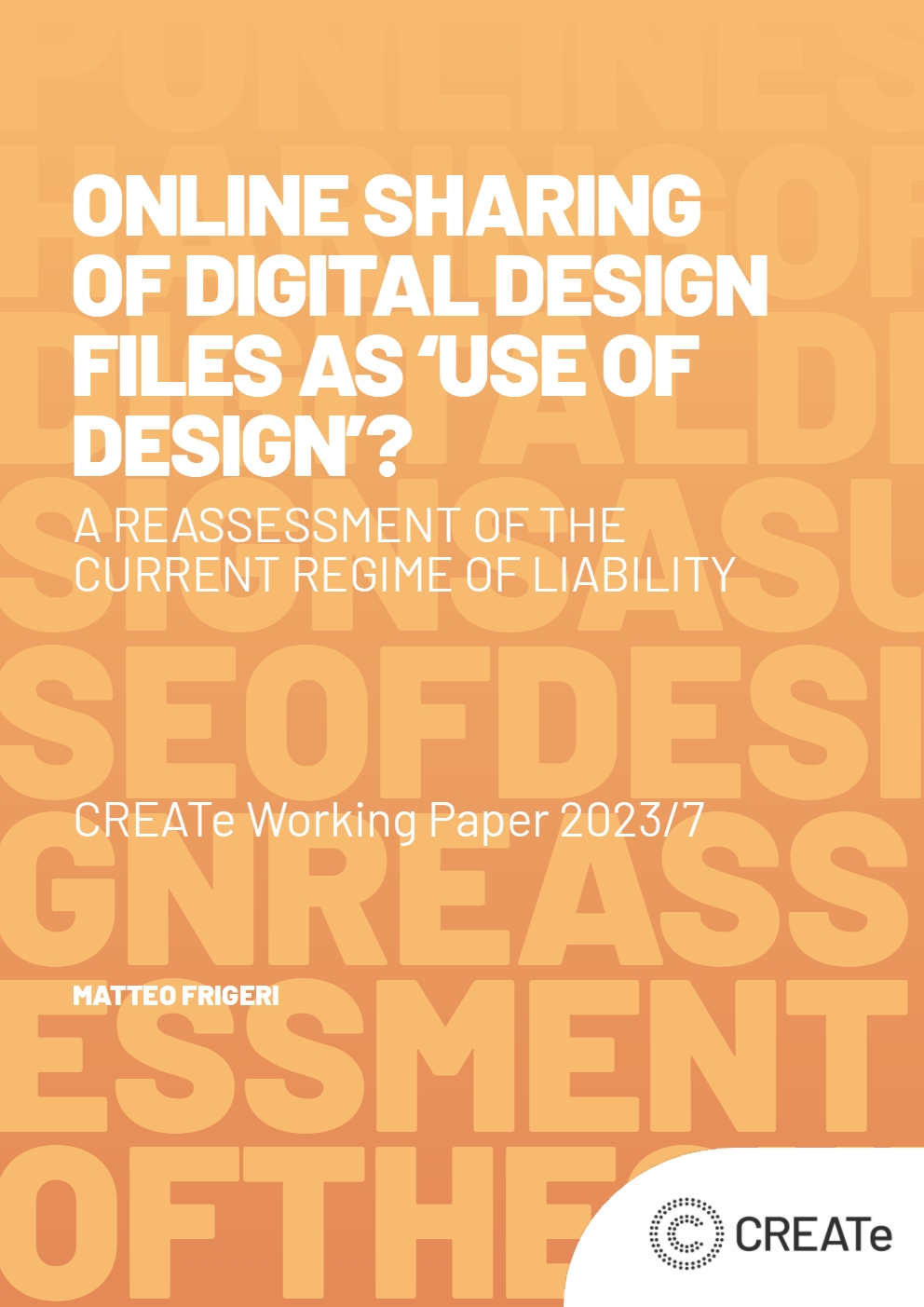This week CREATe is glad to announce the publication of a new working paper. The paper ‘Online sharing of Digital Design files as “use of a design”? A reassessment of the current regime of liability’ by Matteo Frigeri, a Researcher at CREATe, University of Glasgow is a pre-print version of an article due to be published in JIPITEC 14(3) 2023. The article is based on the LL.M. dissertation that Matteo developed at KU Leuven. From September 2023, Matteo will be working as a legal researcher at CiTiP, KU Leuven.
When compared to the analogue forms of intellectual property, EU design law often appears as lacking the same distinct identity that characterises trademark or copyright. From its inception, the divergent conceptions of what design rights should protect have been coexisting mostly unnoticed, hidden behind the façade of a fully harmonised legal framework and – in truth – causing little practical problem.
New developments in technology, social practices and business models now compel us to question the applicability of design protection to emerging forms of digital creation, distribution, and consumption of designs. Making these reflections especially urgent is the looming threat of mass-sharing of digital design files online. Despite being frequently mentioned in policy discussions at the EU level, the infringement of design rights online is still poorly documented. In addition, it remains uncertain whether and to what extent such acts are sufficient to give rise to liability under the current legislative framework, thus preventing us to fully appreciate the scale of the problem.
More certainty over the liability of online users and platforms is necessary to safeguard the system of incentives for the creation and distribution of high-quality designs whilst promoting digital creativity and innovation. The objective of this Working Paper is to evaluate the protection that the current design regime provides to designers against the sharing of files incorporating their creations – the digital design. Additionally, this paper outlines some tentative recommendations for possible solutions to reduce the uncertainty surrounding the scope of protection under Design law, in the process commenting on recent developments at the EU level.
The timely contribution this article makes is underlined by the recent publication by the European Commission of a Proposal for a Regulation on Community Designs. This document represents an ambitious adaptation of the property regime established by the earlier Design Regulation and Directive. Its publication followed an intensive period of the legislative framework review, a debate that has largely focused on offering legal solutions to the challenges brought forward by the development of 3D printing technologies. Throughout these discussions, the commonly held position treated design rights as capable of extending to the reproduction of a design without any physical embodiment, whether in digital format (e.g., in a gaming environment) or printed on a physical object (e.g., a representation of a design in a book).
Espousing this conception of what a design is raises, however, several problems. For example, under this conception, design law risks to significantly overlap with copyright protection despite that no corresponding set of exceptions exist to safeguard legitimate uses of designs and freedom of expression.
There are also several practical issues likely to arise in the future. As the Working paper highlights, it does not seem that design rights can cover acts of sharing of a digital file unless the appearance of the design is also reproduced. Consequently, the design holders’ protection can be ensured only inconsistently in the digital world, and – in any case – any potential liability could be easy to circumvent.
The Commission Proposal attempts to tackle these issues, yet it falls short of conducting a more comprehensive re-evaluation of the fundamental purpose of Design law. It overlooks the crucial question of why we have design rights in the first place and fails to properly define the boundaries of this property right.

3D printing of a hair comb. Photograph by Tom Claes.
At the same time, the Commission also expanded the scope of protection to cover acts such as sharing or distributing of digital design files. This development is commendable, especially as it ensures that liability can be established even if the design’s appearance is never reproduced. Yet it is not apparent why the Commission also felt necessary to restrict this right only to a specific purpose: the printing of the product in physical form – in other words, for the purpose of 3D printing.
Restricting the exclusive right of sharing the designs online to acts done for the purpose of 3D printing is prima facie inconsistent with the existence of design protection for mere reproductions of a design. This incoherence is destined to raise numerous questions to which there are no readily apparent answers: would acts of sharing or distributing design files also be eligible for protection when the designs are solely intended for digital consumption, such as in the context of gaming? If mere reproductions are within the exclusive rights granted by EU design, why did the Commission refrain from explicitly stating as much in Article 19? The current Proposal already feels like a missed opportunity to reduce uncertainty.
Though not offering definitive answers itself, the present paper provides a more informed understanding of the conceptual architecture of design law. Its main objective is to critically examine claims regarding the scope of design rights protection by reviewing the jurisprudence, literature, and legislative history of design law.
While it focuses on the online sharing of digital files, this paper also provides a more general framework against which to evaluate the recent Commission Proposal. The paper argues that the Commission failed to engage with the broader conceptual issues currently afflicting design law. The proposed amendments are an ad hoc response to, in the words of the Commission, ‘the challenges brought by the increased deployment of 3D printing technologies’. As a result, this legislative intervention may reveal itself to be short-sighted, ignoring other forms of digital exploitation (e.g., in-game and purely digital consumption of designs) while also failing to increase the inherent conceptual flexibility of Design law. In contrast with this approach, this paper provides a compelling argument in favour of clearly spelling out what immaterial forms of exploitation are to be captured by this property right to reestablish conceptual clarity in a right that is currently missing a clear identity.
Abstract
This review demonstrates that the extension of protection to forms of immaterial exploitation of designs may have been an unintended result facilitated by the ambiguous choice of wording of the legislation. The last section of the article assesses the potential liability for the sharing of a DD file in a platform environment, a question also recently considered by the Commission’s study. After recognising the crucial role of the “appearance” of a design as a condition of liability, the article discusses how this may cause Design law to be inconsistent or ineffective in tackling the online sharing of designs.
In the conclusion, a few possible solutions are canvassed. It is submitted that the current Commission Proposal does not satisfactorily address the conceptual issues outlined in the article, risking rather being a short-sighted and unprincipled response to a much broader necessity: a general reconceptualisation of what design should protect in the digital ecosystem.
Full paper can be downloaded here.




